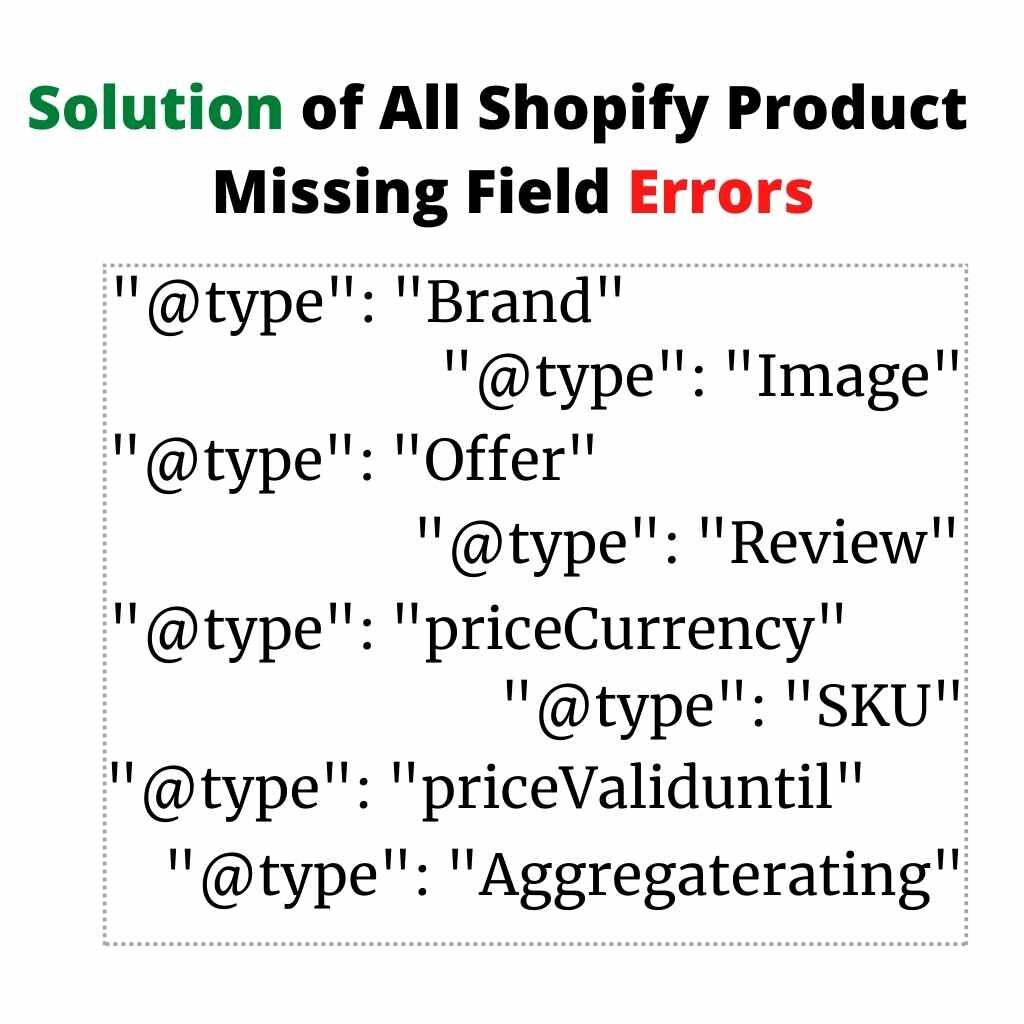I know you are frustrated after searching many web pages and the Shopify community not getting the proper guidelines to fix Shopify Product Schema errors.
Don’t worry; if you haven’t used Shopify before, we have provided a to z Shopify product liquid. The Shopify product schema will help you add structured data markup to your store. It ensures the products would appear in search results.
Product in the enhancement section of the Google Search Console shows a missing field error after successfully crawling by the Google bot. I wish you would find it easily by using any online schema generator.
Adding Google structured data or schema markup is easy. Still, it’s time-consuming, and you also need to have strong knowledge of Shopify liquid Fortunately, you can do it yourself if you are a Shopify pro. There are a variety of resources available to help you understand the basics of Shopify Liquid Coding, which is also often referred to as cheat sheets.
Shopify liquid is different from other types of CMS. To optimize the search engine optimization for your products, you need to use the product structured data according to the Google product structure data guidelines. If you add markup on your product pages, Google or any search engine will provide detailed details about the product as a rich result , which includes images of the product. Searchers can see price, review, SKU, priceValidUntil, aggregateRating, priceCurrency, brand, etc.
Using markup enabled for product-rich results or rich snippets lets you attract your target customers, looking for items to purchase in Google search. Those markups let your product pages maintain the accuracy of your information, so your customers find the relevant and Google.

To fix the Missing field “image,” input that liquid.
“image”: [
{{ product.featured_media | img_url: media_size | prepend: “https:” | json }}
],
Fix Missing field “name”
“brand”: {
“@type”: “Brand”,
“name”: {{ product.vendor | json }}
},
Fix Missing field “author”
“author”: {{ customer.first_name |json }}
Fix Missing field “brand”
“brand”: {
“@type”: “Brand” }
Fix Missing field “SKU”
“offers”: [
{%- for variant in product.variants -%}
{
“@type” : “Offer”,
{%- if variant.sku != blank -%}
“sku”: {{ variant.sku | json }},
{%- endif -%}
Fix Missing field “review”
“review”: {
“@type”: “Review”,
“reviewBody”: {{ comment.content | json }},
“author”: {{ customer.first_name |json }}
},
Fix Missing field “aggregateRating”
“aggregaterating”: {
“@type”: “AggregateRating”,
“ratingValue”: {{ product.metafields.spr.reviews | split: ‘ratingValue” content=”‘ | last | split: ‘”‘ | first | plus: 5 }},
“ratingCount”: {{ product.metafields.spr.reviews | split: ‘reviewCount” content=”‘ | last | split: ‘”‘ | first | plus: 5 }}
},
Fix Missing field “priceValidUntil”
“priceValidUntil”: “{{ ‘now’ | date: ‘%s’ | plus: 31536000 | date: ‘%Y-%m-%d’ | uri_encode | replace:’+’,’%20′ }}”,
Fix Missing field “@type”
“@type”: “Brand”
Fix Missing field “priceCurrency”
“priceCurrency” : {{ cart.currency.iso_code | json }},
Without using Shopify product schema, you’re missing out on major SEO potential. Moreover, you can follow the beginner to advance guide for structured data in SEO by using Google tag manager, plugins, or manually.
Those are individual product schema liquids; I have shared the full product schema coding.
This special XML file describes the product attributes and their corresponding metadata. If you don’t use the Shopify product schema, you’re missing out on SEO potential.
You can add that XML markup to your product liquid or any other page on your website. That will automatically generate a unified product schema for your products. In addition to product pages, you can add structured data to collection pages, blog posts, and articles. By including XML into your product, you’ll be able to provide the most enjoyable customer experience for your clients. It will improve your conversions, pass link juice, and index new pages quickly.
You can also add it to your home page, collection pages, blog, and article pages to make it more appealing to search engines. These features will also improve your site’s mobile and desktop experience. The crucial schema for a Shopify store is breadcrumb, organization, website/sitelinks, and product schema (discussed above.)
Without touching the Shopify liquid, you can implement those schemas with help from Google Tag Manager. You can generate those schemes with any online structured data generation tools like technical SEO and extension is .com; just put your desired info to get them fully custom. If you want advanced custom schema markup coding, comment on what you want. We will email you the custom schema markup as per your choice.
Why do we need those schema fields such as “priceValidUntil”, “aggregateRating”,”priceCurrency”, “sku” ?
Why “priceValidUntil”
To have a perfect product catalogue, you should be able to configure the product’s price. You must use your theme’s “priceValidUntil” property to do this. That will ensure that your customers know when the product will start selling. However, this property can’t be used for products with set prices. Luckily, it’s easy to fix this problem in Shopify.
Why “aggregateRating”
It helps show the 5-star sign in search engine result pages, increasing the conversion rate. The properties of Aggregaterating are itemReviewed, ratingCount, reviewCount, “description”, “name”, alternateName, additionalType, URL.
Why “GTIN”
The GTIN is also the same as the product name. It is a unique code that helps Google match your search query with your products. The GTIN is a unique ID, but it can also be used for the MPN. By using the product’s unique code, you can improve your website’s SEO by optimizing your site for this information.
Why “review”
Review schema markup increases online visibility and trust and improves customer loyalty. These are user or customer-generated and offer real-time reviews by real customers. There is no way to generate fake reviews or paid reviews. For instance, if three customers provide reviews after buying any product and service, it will show in the SERPs, but after the search bot crawls. It’s not automatic due to Googlebot. Firstly, It will be crawled by a search bot to index the authentic reviews. It seems so safe.

I have a question! Your blog post on schema was great, but can you tell me, where *exactly* do I put that line of code for missing “image” field? I don’t have a product.liquid in Dawn Theme, I have “main-product.liquid” and also “product.json”. I tried entering your code but I don’t know anything about CSS and it seemed I created some syntax issue, it wouldn’t let me post it.
I’m desperate! Thanks for your help